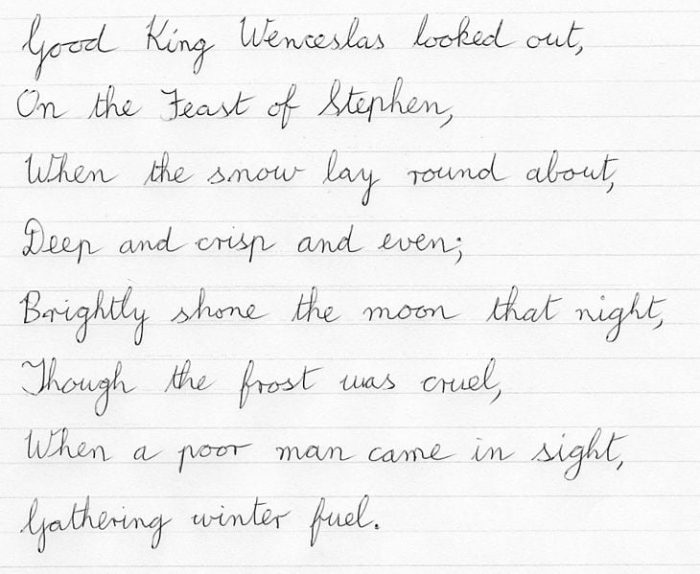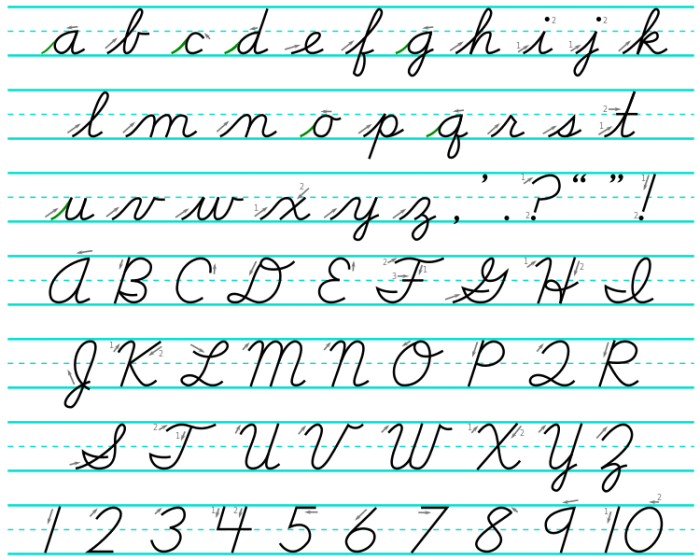
Want to learn how to write a capital cursive S? Read on to find out and find out some interesting facts about cursive.
The process for writing a capital cursive S is something like this:

Start out by making a slanted figure eight. Start in one corner of the figure eight and trace the line up and to the right, curving back around towards the left as you create the other half of the top of the eight. Then you’ll cross the line you just made, going downwards.
Trace a wide arc back towards the left of the figure eight, but instead of connecting it where the original line started, aim slightly higher than that and go through the first line until you have drawn a small tail for the figure. Now you’ll finish by drawing the tail back right towards/through the body of the eight.
That’s how you draw a cursive capital S. What about a lowercase cursive S? A lowercase cursive s is a slanted triangular figure that has one long trail trailing off to the right. Begin by making a small triangle or teardrop shape, starting at the left and going up to the top, and then curving down to the left again to connect the two lines. Now you will just give the shape a long tail stretching out to the right.
“My spelling is Wobbly. It’s good spelling but it Wobbles, and the letters get in the wrong places.” — A. A. Milne
As for the other letters of the cursive alphabet, you can see them by clicking on this link here. Both capital and lowercase letters are included. Note that much as print letters have their own fonts, so do cursive letters. This means the letters may look a little different depending on which source you view. However, the basic shape of the letters should be the same.
Facts About Cursive
It is usually accepted that the reason for writing in cursive, also sometimes called longhand or script (in contrast to print letters), is that it makes the act of writing faster. This is because the letters are joined together in a flowing style, which negates the need to lift one’s writing tool as many times. There are variations on cursive that may include more spaces/lifts, but in general, cursive is joined together. There are also subtypes of cursive such as looped cursive, italic cursive, and ligature.

An example of looped cursive. Photo: Public Domain
Italic cursive is distinguished from other forms of cursive by the fact that it uses few or no looped joins. Specifically, there are no joins from the letters Y, Q, J, or G, and the style was mainly used throughout Italy during the Renaissance period, hence the moniker italic. Note that this is distinguished from italic type characters, which just means that the letters are slanted in appearance.
“Handwriting is a spiritual designing, even though it appears by means of a material instrument.” — Euclid
Ligature cursive is the process of connecting the different letters of words with lines that join the beginning and ending letters, meaning that one rarely has to pick up their writing implement between letters at all. Finally, looped cursive is what people generally think of when the term cursive is said, and the ascenders/descenders in looped cursive have unique loops that assist in joining the letters together.
Is Learning Cursive Really Necessary?

Photo: AndrewBuck via WikiMedia Commons. This file is licensed under the Creative Commons Attribution-Share Alike 4.0 International, 3.0 Unported, 2.5 Generic, 2.0 Generic and 1.0 Generic license.
Since around the 1950s or 1960s, the United States has taught cursive in most of its schools. However, in the 21st century, cursive is perceived by many to be an unnecessary skill. Some schools and teachers have called cursive a dying art. A study conducted in 2007 found that approximately half of all second graders and 90% of all third-graders in the US had been given instruction in cursive. Despite this, in 2006, only around 15% of students who took the SAT wrote their test answers and cursive. Some states, like Hawaii and Indiana, have decided to no longer mandate the teaching of cursive, choosing instead to focus on keyboard proficiency, which reflects the growing reliance on computers for communication.
Yet a while cursive may be dying out in some areas of the country, some teachers, historians, and scientists argue for its preservation. Cursive is of historical interest because many important documents are written in cursive, and the inability to read cursive means it is difficult to interpret important documents in their original, untranslated form.
An Argument About Cursive Benefits
Some educators argue that learning cursive is an important part of developing clear, concise handwriting in general and that having neat handwriting is important because it helps students develop language skills like writing and reading faster. There does seem to be some support for the idea that writing things down, instead of typing them, improves one’s recall and conceptual understanding of the material. Certain studies have found that when students who take notes by hand and students who take notes via computer are compared together, those who took notes by hand show greater understanding of the material and better factual recall.
“You can tell a lot about a person by their handwriting.” — Pete Doherty
That said, it isn’t clear that writing in cursive is what increases a student’s understanding of a material, rather than the act of simply writing the material down in a physical format, no matter the type of writing used. Other researchers have challenged the claims that cursive writing improves cognition or motor skills, arguing that many of the benefits people attribute to cursive are simply because cursive looks better and that evidence doesn’t support such claims. Another criticism is that many studies purporting to show the benefits of cursive have been misinterpreted or misrepresented.
Whether or not you believe that cursive has a cognitive benefit, if you want to get good at cursive writing, there is only one way to do it: practice. You can procure a list of cursive letters, and then practice writing them daily until you are proficient with the writing style. As with any skill, continuing to practice will help refine the skill and improve your penmanship.








